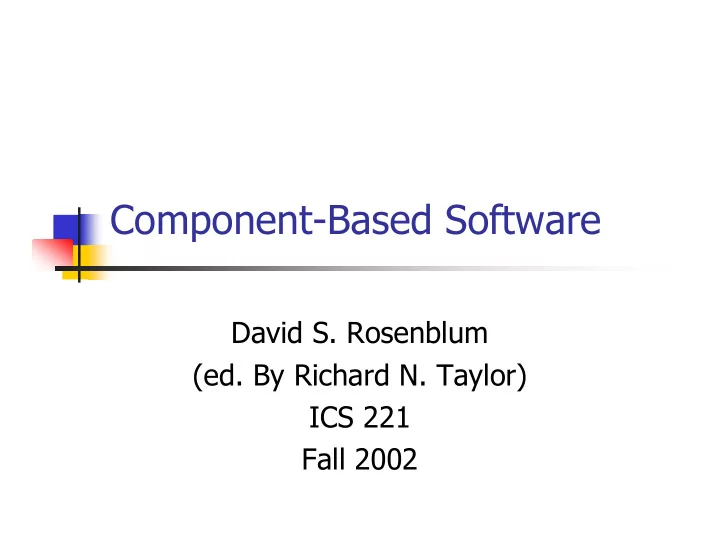

Component-Based Software David S. Rosenblum (ed. By Richard N. Taylor) ICS 221 Fall 2002
Components and Reuse n Develop systems of components of a reasonable size and reuse them n Repeated use of a component n Adapting components for use outside their original context n Extend the idea beyond code to other development artifacts
Goals of Reuse n Goals of reuse are primarily economic n Save cost/time/effort of redundant work, increase productivity n Decrease time to market n Improve systems by reusing both the artifact and the underlying engineering experience n Economic goals achieved only when units of reuse reach critical mass in size, capability and uniformity n But quality is another motivation
Historical Origins n Idea originally due to Doug McIlroy “Mass Produced Software Components”, 1968 NATO Conference on Software Engineering n Reusable components, component libraries n Named as a potential “silver bullet” by Fred Brooks (1987) n Much research interest in the ’80s and ’90s n Technical and managerial barriers have prevented widespread success n This led McIlroy to believe he had been wrong!
Musings on McIlroy… n Granularity n Degrees of variation n Means of achieving specialization n Means of composition, and reasoning about composed systems
From Reuse to Component- Based Development n The term reuse is a misnomer n No other engineering discipline uses the term n Systematic design and use of standard components is accepted practice in other engineering disciplines n The term will (eventually) become obsolete n The important ideas behind reuse are centered on the notion of components n Design of components for use in multiple contexts n Design of families of related components n Design of components with standardized packaging
Different Flavors of Components n (Reusable) Third-Party Software Pieces n Plug-ins/Add-ins n Applets n Frameworks n Open Systems n Distributed Object Infrastructures n Compound Documents n Legacy Systems
Software Engineering Implications n Traditional software systems n are developed by a single organization n undergo a phased development process n have a synchronized release schedule n have a proprietary design and proprietary component interfaces n have a monolithic code base n go through a painful evolution
Lifecycle Model of Traditional Systems Requirements Requirements Design Design Implementation Implementation Integration Integration Validation Validation Deployment Deployment
Component-Based Development
A Possible Lifecycle Model for Component-Based Software … … Component Component Validation Validation System System Requirements Requirements System System Design Design System System Integration Integration System System Validation Validation “Integrate-Then-Deploy” System System Deployment Deployment
Another Possible Lifecycle Model … … Component Component Deployment Deployment System System Requirements Requirements System System Design Design System System Integration Integration “Deploy-Then-Integrate”
Implications of the Lifecycle Models
A Challenge for Component- Based Software: Testing Unit testing alone won’t cut it Nor will static analysis techniques New dynamic analysis methods are needed
Another View of the Problem Old-Style Development Component-Based Development n Single vendor n Multiple vendors n White-box artifacts n Many black-box artifacts n code, specs, test cases, n code, internal specs, test analysis support, docs cases, analysis support
A (Partial) Solution: Component Metadata Application Component Developer Builder + Development Tools n Metadata = “data about data” n Abstracted information about component internals and development history n Can be accessed via metamethods n Component developer supplies metadata n Application builder exploits metadata n Design time and runtime
Kinds of Metadata for SE Tasks (I) n Information on customizing the component n Component properties n Constraints on properties n Information to integrate the component n Interface syntax n Java reflection, COM QueryInterface, CORBA DII n Generated and consumed events n Interface semantics n Pre/post conditions and invariants n Protocol specs Many of these are “traditional” kinds of component metadata
Kinds of Metadata for SE Tasks (II) n Information to evaluate the component n Static and dynamic metrics n Cyclomatic complexity n Test coverage achieved by developer n QoS information n Pricing/leasing information n Information to test and debug the component n Exported state machine representation n Embedded test suite with coverage information n Input/output dependencies at interface n Dynamically computed coverage information
Kinds of Metadata for SE Tasks (III) n Information to analyze the component n Summary flow information n Control dependencies n Data dependencies n Graph models n Call graph n Control-flow graph n Other information to support software engineering tasks
An Example: Program Slicing public boolean checkingToSavings (String cAccountCode String sAccountCode, float amount) { BankingAccount checking(cAccountCode); BankingAccount saving(sAccountCode); float balance, total; . . . checking.open(); saving.open(); . . . balance = checking.moveFunds(saving, amount); // A . . . total = balance + additionalFunds; // B . . . } n Suppose we want backward slice w.r.t. total at B n Do saving , amount , and/or state of checking influence balance at A ? n Dependency metadata for BankingAccount could tell us!
Implementation Issues: Metadata Format and Naming n Need uniform format for text and non-text metadata n XML n DTDs specify format n Need uniform way of identifying purpose of metadata to users n MIME-like tags describe purpose n Example: analysis/data-dependency for data flow information n Who establishes naming scheme? n How do new metadata get established?
Implementation Issues: Metadata Addition & Retrieval n Need uniform way for a component to expose its particular collection of metadata n Two metamethods n QueryMetadata n Like QueryInterface in COM n GetMetadata(tag, parameters) n Selects metadata according to “tag” n Returns statically-embedded or dynamically computed value n Could operate as an iterator for complex piecewise metadata
Metadata and Testing of Distributed Components n Metadata can be used to aid application of existing testing techniques in distributed object systems n But how should existing testing techniques be changed for distributed components and distributed object systems (and how can metadata help)? n Coverage criteria, reliability models n Testing infrastructure n Test monitoring and oracles
Conclusion n Component-based software is the wave of the future n But there are many software engineering challenges to address n Metadata may provide a solution
Recommend
More recommend